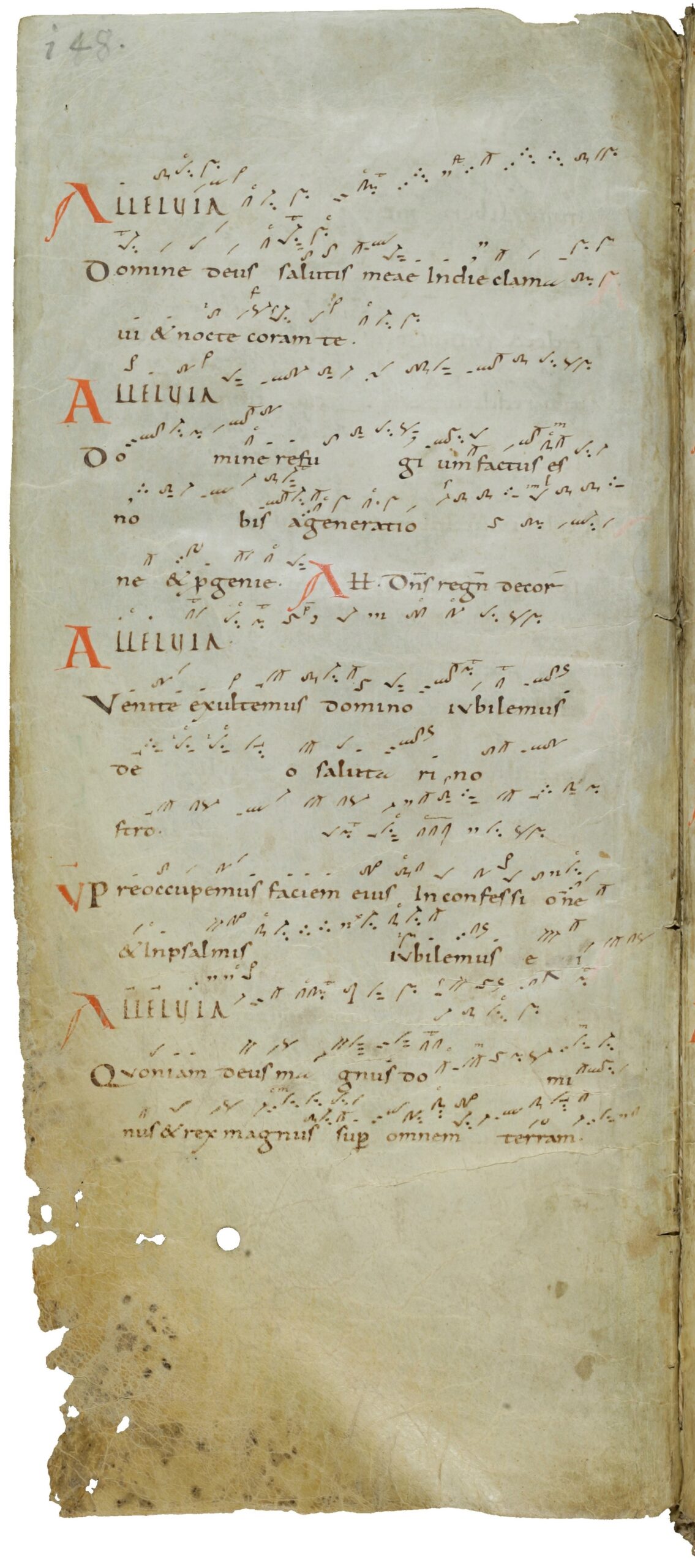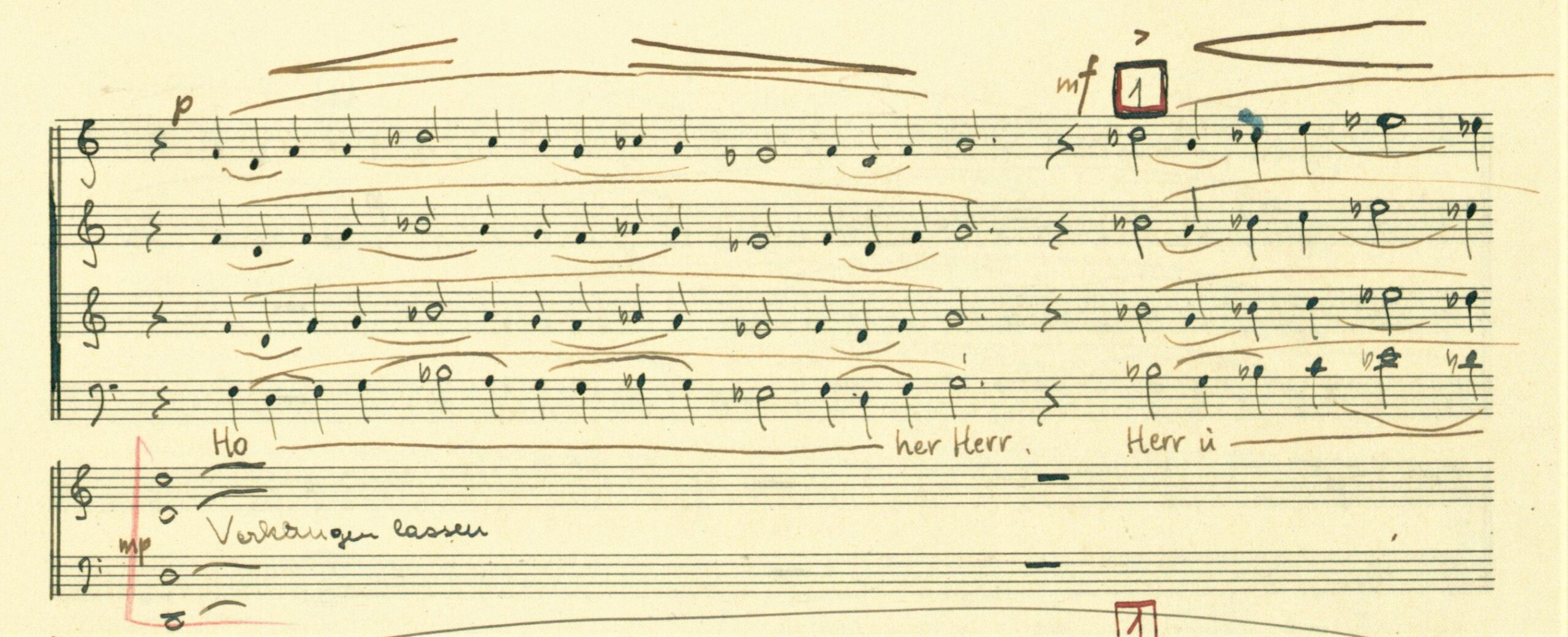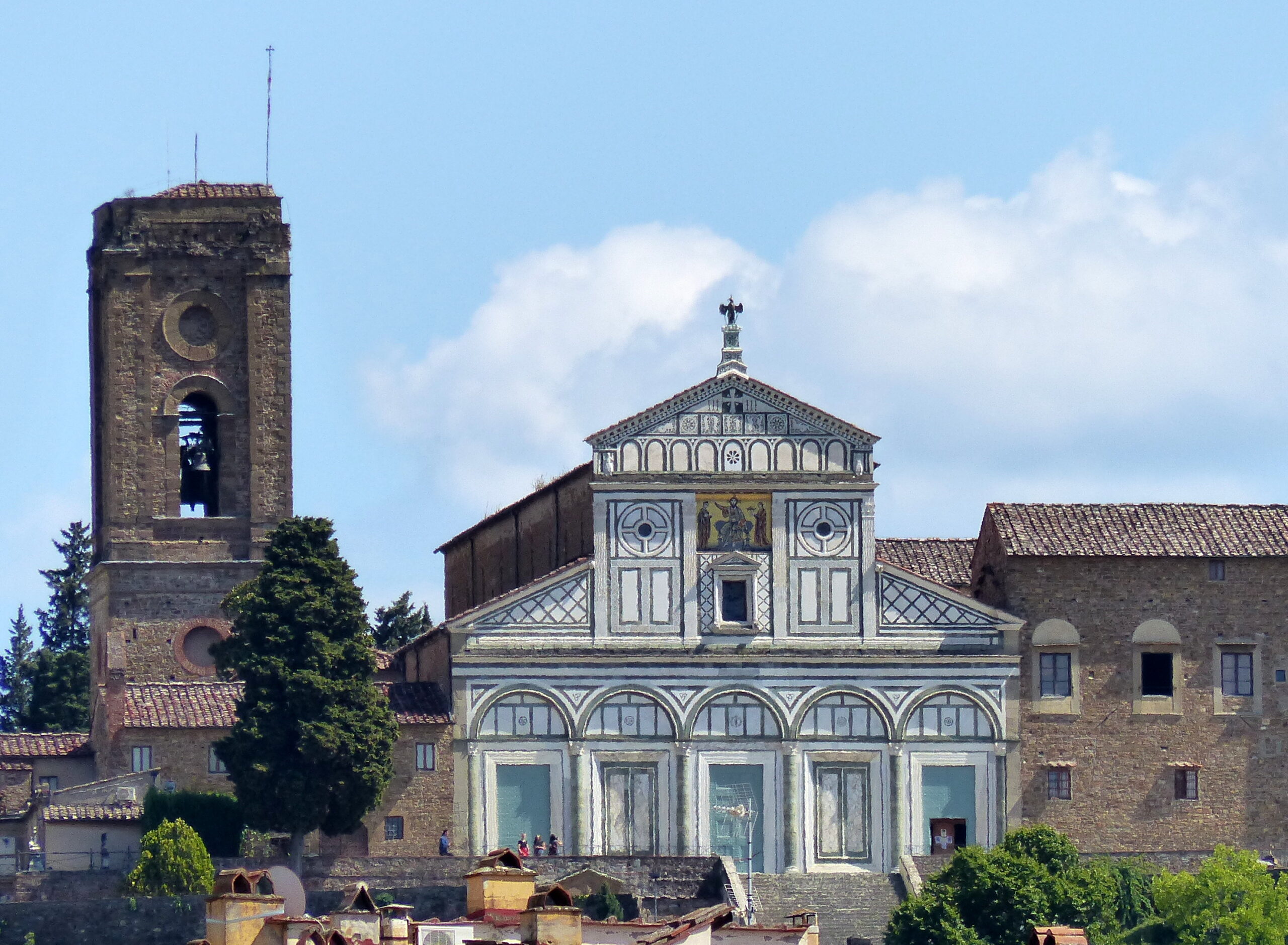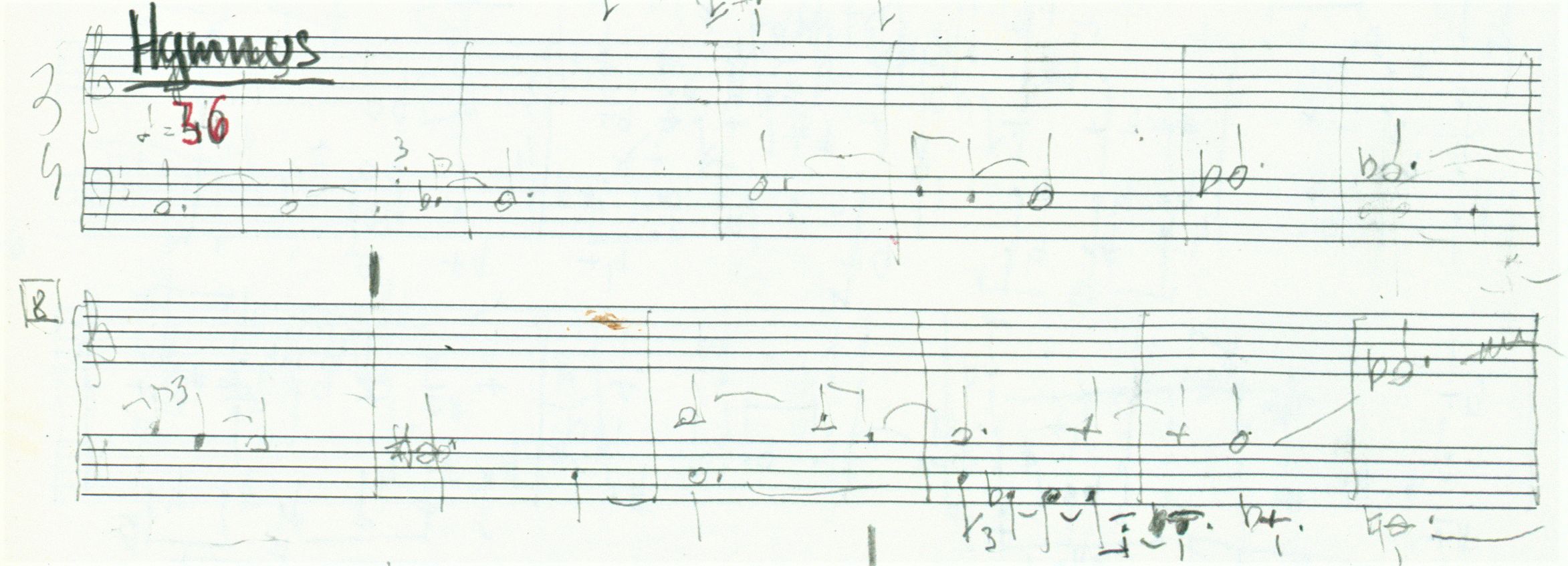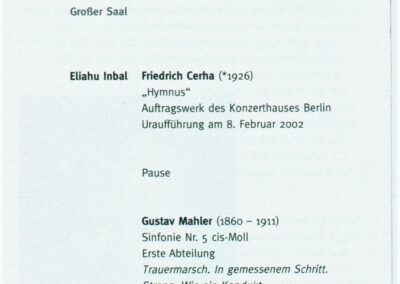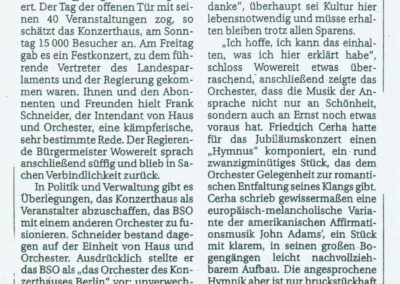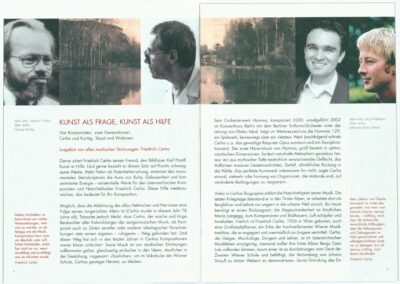Hymnus
A Cathedral of Sound
Paraphrase über den Anfang der 9. Symphonie von Beethoven
Ricercar, Toccata und Passacaglia
Pope Gregory directs a Gregorian chant
Hartker’s Antiphonary (Cod. Sang. 390), St. Gallen Monastery, ca. AD 1000
Prior to the Middle Ages, musical notation was not precise, and it is only because it was eventually written down that it survived for posterity. Western notation is rooted in Gregorian chant. According to legend, Pope Gregory I received the melodies of the Gregorian repertoire from the Holy Spirit, brought to him by a dove. The process is depicted in a codex from around the year 1000, when a scribe, Petrus Diaconus, transposed the music whispered to him on a wax tablet in medieval neume notation.
Source: E-Codices.unifr.ch
What did music sound like in the first millennium after the death of Christ?
We can thank the European monasteries in which the first music manuscripts were written for the fact that this question can be partially answered today.
Codex Sangallensis 359, Cantatorium, p. 148, St. Gallen Monastery between AD 922 and 926
The parchment page shown here is from Codex Sangallensis 359, the first manuscript to record Gregorian chants. Graphic symbols called neumes are written above the text. These provide information about the melodic progression and are among the oldest examples of musical notation. The songs, which probably originated in the early Middle Ages, were passed on through oral tradition for a considerable time. Thanks to these newly developed symbols, they could now be preserved for generations to come.
The oldest music in Western history that has survived to this day seems impossibly far removed from the music of Friedrich Cerha—and yet certain bridges span the millennia. His orchestra piece Hymnus is one of them, a work created at the turn of the millennium that ingeniously tunes in to the sounds of bygone days …
Außenansicht
Cerha’s early work touches on musical themes that then resurface in his later work. These include, for example, Viennese folk and salon music of the nineteenth century—heard for the first time in his youthful piece Gschwandtner Tänze (1938), and again decades later in the two Keintaten (1980-85) and Wiener Kaleidoskop (2006). His intense interest in early music is one of these young leitmotifs that return to resonate later. However, there is a great variety within what is considered “old”, and Cerha’s interest developed across a broad spectrum. On the one hand, he was fascinated by baroque music, and on the other he delved even further back in music history, going all the way to the Middle Ages. In Buch von der Minne the theme is the poetic love songs of the twelfth and thirteenth centuries. The instrumentation of a work by Guillaume de Machaut, the grand master of early polyphonic music, introduces even more colour. In the late 1940s, Cerha edited the “Kyrie” from the Messe of Nostre Dame, written in around 1360, adding in a glockenspiel, triangle, tambourine, and snare drum to the choral sounds.Joachim Diederichs: Friedrich Cerha. Werkeinführungen, Quellen, Dokumente, Vienna 2018, „198_frescobaldiana“, p. 2 But the look back into music history goes even further. Cerha was already enthusiastic about Gregorian chant as a student. The source of his fascination was “an encounter with the medieval fine arts of Italy, the Mediterranean experience of early painting and architecture.“Joachim Diederichs: Friedrich Cerha. Werkeinführungen, Quellen, Dokumente, Vienna 2018, „198_frescobaldiana“, p. 2 The luminous frescoes of painters like Piero della Francesca and Giotto di Bondone hypnotized him. In the 1950s his frequent trips to Italy to research Baroque music in Italian libraries contributed greatly to his impressions. He also enjoyed visiting old churches, which captured the Middle Ages of the Mediterranean region both visually and acoustically.
Giotto di Bondone, scenes from a fresco cycle on the life of Francis of Assisi, Basilica of San Francesco, 1297–1300
Source: Wikimedia Commons
Brücke
The “turn to Gregorian chant” influenced by Italian art Schriften: ein Netzwerk, Vienna 2001, p. 218 bore compositional fruit as early as 1948. This was the year that Cerha began to work on Sonnengesang des hl. Franz von Assisi, a half-hour choral work accompanied by string orchestra and harp. For the piece, Cerha was imagining a kind of music “in which time would be suspended, so to speak”.Cerha, commentary on Sonnengesang des hl. Franz von Assisi, AdZ 000T0028/2The floating character of the Gregorian chant seems in step with these ideas. Many of the choral parts in Sonnengesang reflect features typical of Gregorian chant: They eliminate metre, stretch vowels to infinity, and are sung in unison.
Elements of Gregorian chant influenced other of Cerha’s works over the decades. The tonal vocabulary of his opera composed in the 1980s, Der Rattenfänger, is extremely diverse, yet based on one and the same material. It “was chosen in such a way that both a Gregorian Sanctus and a Protestant chant can be naturally traced back to it.“Schriften: ein Netzwerk, Vienna 2001, p. 253 f. Choral melodies surface at various points in the piece, often shrouded by the orchestra.
At the turn of the millennium, Gregorian chant came back into Cerha’s field of interest when the Konzerthaus Berlin commissioned a new orchestral work. Cerha, who had recently completed the gigantic opera project Der Riese vom Steinfeld , spared nothing in the instrumentation: The new piece was to have 60 strings alone, a work of “Mahler dimensions“.Lothar Knessl, „Versuch, sich Friedrich Cerha zu nähern“, in: Schriften: ein Netzwerk, Vienna 2001, pp. 7-15, here p. 8 The name Hymnus, as the piece is called, refers to the restrained simplicity of the medieval choral melodies, which astonish against a background of such great instrumental dimensions, but the piece proof of how, in Cerha’s compositions, apparent opposites can be united as one.
The inspirations drawn from Gregorian chant relate to “a certain calm, flowing character, in which masses of sound develop that correspond to the contemporary concept of ‘hymnic’,” says the composer.Cerha, commentary on Hymnus, AdZ, 000T0129/2 The ambivalence of the title—not uncommon for Cerha—strives to bring the past and present closer together. Today, the national anthem is probably the most obvious association with the historical term, but hymns, or anthems, exist in other areas as well: There are political anthems, football anthems, anthems for companies and clubs. They all continue the tradition of the “celebratory song of praise” https://www.duden.de/rechtschreibung/Hymne that was widespread in antiquity. In antiquity, however, a hymn was not a profane song to be repeated by the masses, but rather sung poetry with spiritual references, accompanied by a cithara and honouring nature or the gods. Early Western church music eventually appropriated hymns in a different way: Unisonous spiritual songs with several stanzas were written in praise of God and today remain part of every Liturgy of the Hours. “The entire Middle Ages is considered to be the heyday of Latin hymn poetry,” in large part thanks to theologian Bishop Ambrose of Milan, who lived during late antiquity. At least 14 hymns are attributed to him (some disputed), including the well-known “Te Deum”. Cerha heard the piece on a trip to Italy in 1951, “sung by the monks of San Miniato al Monte near Florence from the gate of their Romanesque monastery” Cerha, commentary on Violinstücke, AdZ, Text0005/3 – an impression that stayed with him. A short time later he quoted the beginning of the hymn in the middle movement of his second sonata for violin and piano. The unaccompanied violin intones the melody “flowing, very evenly”, as if it were itself singing a prayer in church.

Cerha, Sonate für Violine und Klavier, 2nd Movement, beginning, 1953
Cerha, Sonate für Violine und Klavier, 2. Satz, Beginn
Ernst Kovacic (violin), Toccata Classics 2013
Basilika San Miniato al Monte, Florence, Italy
Source: Wikimedia
The early experiences with old church music reflected in the orchestral piece Hymnus are not quite as noticeable as in the works from around 1950. Written half a century later, their incorporation leads to a multilayered listening experience that Cerha ensconces in rich colour.
Innenansicht
Hymnus brings together many of Cerha’s typical qualities in a complementary way: On the one hand, the meticulous structuring, and on the other a direct sensuality. A mix of historically anchored suggestions here, independent and unorthodox solutions there. After the premiere of Hymnus, Berlin newspaper Der Tagesspiegel wrote that it challenges one “to listen intensively, as it consistently runs counter to all conventional expectations of a festive ‘hymn of praise’”. Eckart Schwinger, „Bis an die Grenze des Möglichen“, Der Tagesspiegel, 10 Feb. 2002, AdZ, KRIT0022/144 This description reflects spontaneous listening impressions that are primarily characterised by two aspects: the sound fabric and the dramaturgy. The latter follows an arc of suspense that is easy to follow. The composition makes its way from imaginary silence, beginning in the lower volume range with deep string sounds and building up continuously from there. The flow inspired by Gregorian chant moves with utmost calm and concentration. At the “climax of the first part, the sound shatters dramatically”: The slowly plodding masses are pushed aside by whirling figures. They momentarily change the direction, and eruptive explosions and sharp contrasts appear. Only gradually do the goings-on soften again, seeping away and returning to serenity.
The fact that the formal expansion of the complexly detailed orchestral work can be immediately understood and comprehended “from one’s gut” underlines how very accessible it is. The soundscape contributes to this. Displaying dazzling orchestral colours, the work plays with tonal stimuli, and Cerha’s compositional approach shows that it is constructed based upon the sound. As in some previous pieces, such as the Zweites Streichquartett, modifications of the ordinary tempered system play a role. In Hymnus, these modifications play to the overtones. In large sections, the orchestration becomes a superimposed polyphonic game of harmonies derived from the spectrum of the sounds’ frequencies—the individual components of a sound, so to speak. The fact that a violin sounds like a violin and that every human voice has its own timbre is due to the different configurations of overtones. This is where the bridge reaches across to the externally perceptible timbres of Hymnus: The quality of each individual tone plays a major role in the orchestral palette, as well as in the construction of the harmonies.
As Cerha states in his commentary on the work, an “actually simple three-part movement, four-part in the middle of the piece” forms the “basis of the development”.Joachim Diederichs: Friedrich Cerha. Werkeinführungen, Quellen, Dokumente, Vienna 2018, p. 101 This tonal “skeleton” is particularly evident in the expressive sketches of Hymnus.
This sketch not only illustrates the underlying three-part system, but also shows how the extreme diversification of the orchestral apparatus evolves from it. Beginning with just a few voices, the associated overtones gradually “awaken” as the music progresses. Cerha comments in detail on the technical background:
In the first large section, the overtones of each individual note are instrumented gradually, up to the eleventh. The seventh and eleventh overtones, which do not fit particularly well with our tempered system, are notated using flat signs, as customary for quarter-tone notation, thus approximating the physical conditions. By rapidly changing the instrumentation of the overtone spectrum, one overtone range is raised while another is suppressed. At the climax of the first part, there are three times eleven, i.e., 33-part chords.
Friedrich Cerha
Joachim Diederichs: Friedrich Cerha. Werkeinführungen, Quellen, Dokumente, Vienna 2018, p. 101
The sketches show how Cerha conveyed the described overtone structures (with notes on orchestration) beneath the basic movement. All the harmonies notated there are made up of ten tones; together with the root note, they create the eleven parts of each individual element. To a certain extent, the structure is lined with a dense, constructed mass—an almost architectural approach. These gigantic fusions of sound are reminiscent of Cerha’s mass compositions of the early 1960s. And indeed, in terms of monumentalism, Hymnus is not far behind pieces like Fasce or Spiegel .The principle of individuality—in other words, the disintegration of the orchestral groups into numerous single parts—also applies here. Typical of this is, for example, the diversity of the “splayed” corpus of strings. The transformation of the above sketch into the score clearly reveals these principles. Over the course of Hymnus, the passage integrates itself into the climax: While the lower instruments continue to create the previously dominant sound masses, the higher ones are already peeling off, with the overtones coming together to form a chaotic stream of sound.
Cerha, Hymnus, handwritten score, T. 160 ff., 2000, AdZ, 00000129/24
Cerha, Hymnus, Höhepunkt des 1. Teils
Berliner Sinfonie-Orchester, Ltg. Eliahu Inbal, Konzerthaus Berlin, 8.2.2002 (UA)
With kind permission Konzerthausorchester Berlin
Architecture and spatial imagination play a major role in more than just the climax. The sounds of the framing sections are also characterised by “composed reverberation”: “One note does not disappear when the next voice of another instrument arrives, but instead remains and slowly fades out in a diminuendo,” says Cerha.Joachim Diederichs: Friedrich Cerha. Werkeinführungen, Quellen, Dokumente, Vienna 2018, p. 101 The aim was to “approximate the sonority of a tremendous Gothic-hall church”. The spatial image develops like a room that is initially empty but then fills with more and more material. “The reverberation is longest in the beginning” and then “becomes progressively shorter and finally disappears completely.”
Cerha, Hymnus, handwritten score, beginning, T. 160 ff., 2000, AdZ, 00000129/5
Cerha, Hymnus, Beginn
Berliner Sinfonie-Orchester, Ltg. Eliahu Inbal, Konzerthaus Berlin, 8.2.2002 (UA)
With kind permission Konzerthausorchester Berlin
Cerha also mentions another structural peculiarity of Hymnus: “As with the hymns of the fifteenth and sixteenth centuries,” he explains, “a cantus firmus runs through the entire piece like a backbone”.Joachim Diederichs: Friedrich Cerha. Werkeinführungen, Quellen, Dokumente, Vienna 2018, p. 101 It is “a 13-note series that appears in its basic form and in variations” and is “often not audible”. Especially in the beginning, “rudiments of the series” can be “found in all voices.” If one follows the voice progression of the sketch, the note sequence emerges clearly right at the start. The intervals between the notes are rather small (seconds and thirds), thus deliberately evoking a vocal quality. In this, Cerha vaguely ties into the ideals of old church music, while still looking on from a noticeable distance.
Cerha, Hymnus, sketch of the beginning, 2000, AdZ, 000S0128/5
By referring to the hymns of the early modern era, Cerha also tells a tale of the history of European sacred music. In the early Middle Ages, making music in church settings was concentrated entirely on the joined singing of monophonic Gregorian melodies. They were sensuous confessions of the spiritual community, reduced to the essentials. As polyphony flourished, particularly in the Notre-Dame Cathedral in Paris, the relationship to these old traditional melodies changed. They were not forgotten; on the contrary. As cantus firmus (fixed melodies), they remained the centre of much music, and were primarily “used to create sound formations”, enriching and playing with them.Günther Schmidt, „Zur Frage des Cantus firmus im 14. und beginnenden 15. Jahrhundert, in: Archiv für Musikwissenschaft 15/4 (1958), pp. 230-250, here p. 231 f. The sequences of notes were now considered “to be a spiritual, constructively conceived legitimation of the liturgy”, a “basic or core voice”, a role usually taken by the tenor.Günther Schmidt, „Zur Frage des Cantus firmus im 14. und beginnenden 15. Jahrhundert, in: Archiv für Musikwissenschaft 15/4 (1958), pp. 230-250, here p. 232 The cantus firmus was “most alienated from its liturgical task” during the Ars Nova in the fourteenth century, when composers such as Guillaume de Machaut developed highly construction-based processing techniques—with the melody often remaining only as a “fragmentary indication of a skeleton”. This fragmentation was partially left behind again during the Renaissance. The development of European polyphony produced a variety of techniques that enabled artistic adaptations of Gregorian melodies—their former unique position gave way to an integration into more complex contexts. It is precisely this relationship between old and new, between substructure and superstructure, that must have been of interest to Cerha. Many hymns composed during the Renaissance use pre-existing hymnal melodies in one (and sometimes multiple) voice(s), embedded in a contrapuntal structure. The following example from a choir book from around 1515 clearly illustrates this practice: The Gregorian melody appears as a horseshoe nail notation in the tenor. The cantus differs from the other, rhythmically differentiated voices in that the duration of the notes remains the same.

In comparison to these historical ancestors, the cantus firmus in Cerha’s Hymnus also serves the function of a scaffolding, yet its embedding cannot be heard in the same way. At the beginning of the piece, the character traits of the note sequence (although infinitely unfolding) can still be heard, but as the piece progresses, they disappear behind an ever-thicker façade. For long stretches, the cantus still surfaces here and there; its presence cannot always be pinpointed but can always be sensed. The sketches reveal that Cerha used the series in different variations. In addition to the original form, it appears backwards (cancrizans), mirrored (inversion), and mirrored backwards (inverted cancrizans). When the cantus is in the upper parts (e.g., the violins), it is most clearly recognisable in its orchestral environment. However, it is always veiled to a certain extent, since other, often closely related melodic lines continually run alongside. This causes the music to be constantly shaped by ambiguity. In the sketches, Cerha uses red pencil to mark the beginning of the cantus in one of its four forms—an analytical and compositional process, so to speak, that helps maintain an overview of the proliferating material.
Cerha, Hymnus, sketch of the start of an inverted variant (U) of the cantus firmus in the upper part, 2000, AdZ, 000S0128/6
Cerha, Hymnus, Cantus firmus in den Violinen, T. 62-73
Berliner Sinfonie-Orchester, Ltg. Eliahu Inbal, Konzerthaus Berlin, 8.2.2002 (UA)
With kind permission Konzerthausorchester Berlin
The importance of Hymnus as a solemn praise is most apparent after the climax of the first part. After the carefully constructed overtone structure has collapsed, Cerha begins to play with echo effects in the tonal “field of debris”. Hopping on the strings with the bow (“saltando”), “the violins […] fan out […], tones doubling one after the other and one above the other in six different metres, the overtones fanning out up to the eleventh.“Joachim Diederichs: Friedrich Cerha. Werkeinführungen, Quellen, Dokumente, Vienna 2018, p. 101 Beneath this shimmering surface, Cerha celebrates the cantus firmus in bold colours, a practice used again later in Konzert für Schlagzeug und Orchester . Here and there a mighty chorale unfolds, carried by deep brass horns. In Hymnus, the trombones first sing the cantus firmus in its original form, then the horns follow, reading it backwards. In both cases, the first notes of the cantus are reinforced by additional instruments (in the first by the bassoons, in the second by clarinets), emphasizing the entrances of each. However, the entries of new voices cause it to disappear again in the crowd, making room for a new, powerful structure: This time a “forty-four-note movement” emerges, even more colossal proportions of music piling up to form a resounding cathedral.
Cerha, Hymnus, sketch of the cantus firmus played by the trombones, 2000, AdZ, 000S0128/13
Cerha, Hymnus, Aufbau des zweiten Teils
Berliner Sinfonie-Orchester, Ltg. Eliahu Inbal, Konzerthaus Berlin, 8.2.2002 (UA)
With kind permission Konzerthausorchester Berlin
This natural flow of sound, the recapturing of the imagined “Gothic” reverberation, defines Hymnus for a considerable time after these uprisings, until the end. “It lacks the nervous rush of much contemporary music entirely,” comments Cerha, making it clear that he wants his work to be understood as an antithesis. He made a similar statement about an orchestral piece he wrote a good ten years earlier, Monumentum, which resembles Hymnus in its expression: “I find the hecticness, the excitement in many kinds of music of our time to be pointless. […] The concentrated, simple calm and power” of Karl Prantl’s stone sculptures inspired Cerha to find something similar in musicSchriften: ein Netzwerk, Vienna 2001, p. 257 – an approach learned through sculpture and which was brought to fruition in Hymnus, Cerha’s cathedral of sound.

